Horse Art, Animals in Motion |
|||||||||||||||||||||
|
Page 06 / 07
What, then, can we discover " by a kind of scientific sense " from Rodin ? Confidently to give play, I think, to our instinctive preferences when in front of nature, allowing her to disclose to us what she will, and to try through the study of successful effects, both our own and others, to discover the cause of their effectiveness. 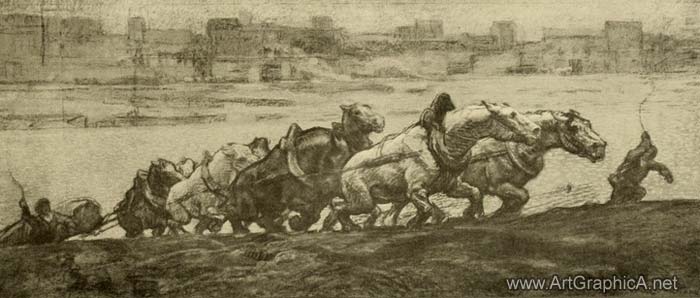 TIMBER-HAULING ON THE SEINE. Horse art, drawing. For as Reynolds says earlier in the passage from which I have already quoted, " It must of necessity be, that even works of Genius, like every other effect, as they must have their cause, must likewise have their rules : it cannot be by chance that excellencies are produced with any constancy or any certainty, for this is not the nature of chance." The proper manner of such inquiry is given by Browning in a letter of advice upon the work of a young poet, in which he tells him to " study the secret of the effectiveness, whatever poetry does affect him -- not repeating, or copying those effects -- but finding out, I mean, why they prove to be effects, and so learning to become similarly effective."
To return, however, to our impressions of nature ; among the more gross effects which we all notice and accept are the lines made by the falling rain and the disappearance of the spokes of a rapidly turning wheel. But there are an infinite number of less obvious effects and changes of appearance associated with movement in nature of which certain artists instinctively make use, especially modern artists since the development of impressionistic realism -- such as indistinctness, confusion, reduplication and even apparent deformation. We shall agree as to the confusion and indistinctness due to movement in nature. And in art examples are not hard to find. Millet in his " Woodman " makes the hand that swings the chopper less distinct than the hand that holds the faggot. We shall agree, too, I think, about reduplication. Does not a cane in rapid vibration give a double image through being more distinct at either limit of its oscillation ? Daumier in his " Mountebank " beating a drum draws the drum-sticks with double tips.  SPRINGING 'EM.. Horse art, drawing. As regards deformation, there may be some disagreement, and yet it is a truth to nature that is instinctively employed for expression in art. Difficult as it may be to realize it in subtler instances, if we take the simple case of the appearance of a circle created by an object swung rapidly about a centre, we shall notice that, as it acquires motion, it not only becomes less distinct but is also elongated in the direction of its flight. 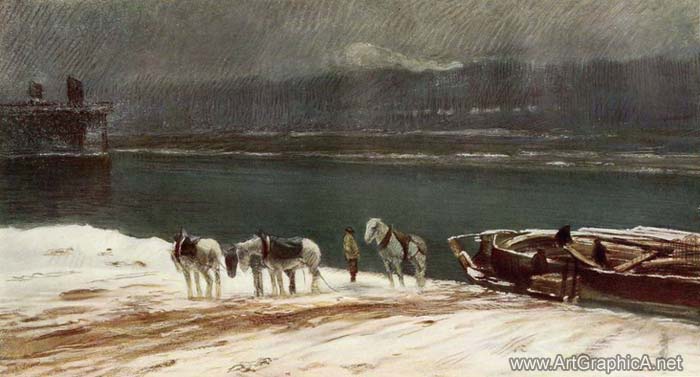 THE SEINE : WINTER. Horse art, painting. A very noticeable instance of deformation occurred one evening at the circus, where an acrobat was juggling with a number of sticks, which he made to turn rapidly over and over as he tossed them in the air. The sticks, though straight in themselves, appeared so curved that anyone who had not seen them at rest before the performance began would have denied that they could be straight. This is but an extreme instance of what often appears in the limbs of men and animals in motion. Another instance was that of a photograph of a racing motor-car. The photograph of the motor-car had been taken with a shutter that was not rapid enough for such a subject, thereby approaching the condition of human sight. It showed the rim and spokes of the wheels distinct and exact where the tyres touched the ground, but blurred and pulled forward at the top where they were advancing more rapidly.* 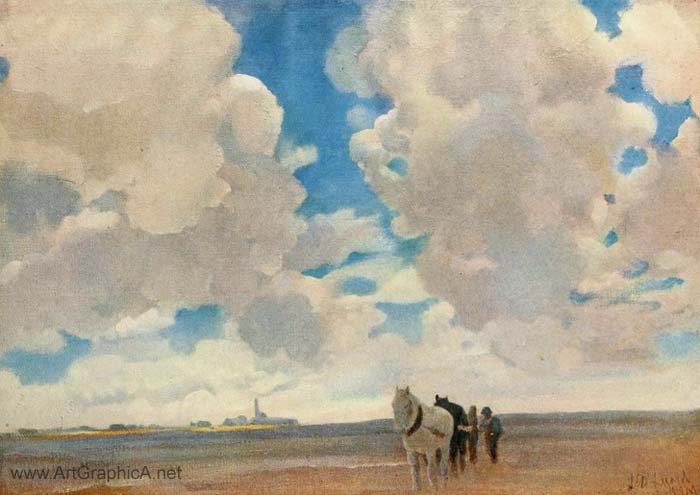 A SUMMER SKY.. Horse art, painting. The duty of the spokes, which are the legs of the machine, is to thrust forward the axle to which the car is attached, just as its foot and leg thrust forward the horse. We are so much inclined to watch the mass of the horse as it gallops that we think of it as swinging its legs to and fro past the indistinct landscape ; we do not observe the hoof stationary upon the ground propelling the animal forwards. Yet this is actually what occurs, and such pauses in the motion affect our impressions, so that as a man or animal leaps, fights or dances, a tail, a sword, a piece of drapery, a foot, a hand will sometimes seem to hover or lag behind, even making the limb appear too long.
The artist in his truth to his impression will be led insensibly to see and use such accurate " inaccuracies "upon which the exact effect depends. For such " inaccuracies " are but normal alterations of appearance due to movement, which correspond in principle to the fact that colour is modified by the colour that is placed against it, or that a white flagstaff, which looks light against a house, looks darker and thinner where it comes against the evening sky above it, and must be so painted to give the effect, although we know it to be actually of the same tone throughout its length. And so it is not only for the pattern of the picture that the leg which is too long in Rubens, the limb which is deformed in Degas, are right, but also in truth to the natural appearance for those who can see. Or to take another instance, are not trees at a distance certainly as green of leaf as those near by ? Yet who would argue that we ought to paint them so, denying the modification to blue due to intervening atmosphere ? And yet the first distant trees painted blue must have shocked the early art patron. 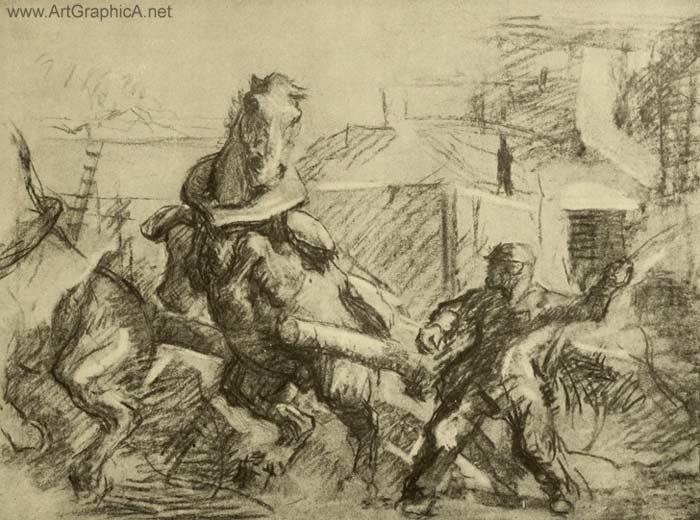 THE SHIRKER. Horse art, drawing.
Next Page
Prev PageHorses and Movement Patterns Rhythm Movement
|
|||||||||||||||||||||
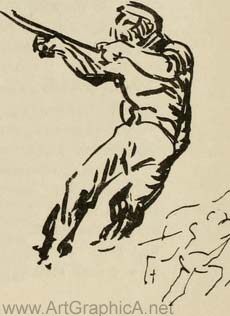 I have attempted something of the sort in this article, and I hope that it may help to the better understanding of the work of certain men, by showing that there is reason for and truth in the effects that they employ. I think also that our attempts at analysis should encourage the artist. If there is a reasonableness behind the effects we have been discussing, why should there not be an equal reasonableness behind his own impressions ? That he can explain or find a reason for them can be of no importance, so long as he can " work from them with as much certainty as if they were embodied upon paper." For instinct leads and theory follows, as we see in the fact that the laws and rules of all arts are formulated upon the discoveries of each new true creator.
I have attempted something of the sort in this article, and I hope that it may help to the better understanding of the work of certain men, by showing that there is reason for and truth in the effects that they employ. I think also that our attempts at analysis should encourage the artist. If there is a reasonableness behind the effects we have been discussing, why should there not be an equal reasonableness behind his own impressions ? That he can explain or find a reason for them can be of no importance, so long as he can " work from them with as much certainty as if they were embodied upon paper." For instinct leads and theory follows, as we see in the fact that the laws and rules of all arts are formulated upon the discoveries of each new true creator. * Some reader may perhaps exclaim " one part. of a wheel can't advance more rapidly than another ! " Rotate faster, no ; advance, yes. The diagram shows the positions of two points on opposite sides of the wheel called AI and B1, and the positions called A2 and B2 which they hold when the wheel has made a half rotation. It is clear that Bl, by dipping to the ground and rising again to B2, has only advanced the distance between 2 and 3 on the ground plan, while A' travelling over the top of the wheel to A2, has advanced the whole distance from i to 4. It would next he A's turn to lag and B's to advance rapidly.
* Some reader may perhaps exclaim " one part. of a wheel can't advance more rapidly than another ! " Rotate faster, no ; advance, yes. The diagram shows the positions of two points on opposite sides of the wheel called AI and B1, and the positions called A2 and B2 which they hold when the wheel has made a half rotation. It is clear that Bl, by dipping to the ground and rising again to B2, has only advanced the distance between 2 and 3 on the ground plan, while A' travelling over the top of the wheel to A2, has advanced the whole distance from i to 4. It would next he A's turn to lag and B's to advance rapidly.







